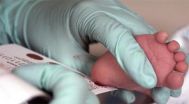(Press-News.org) "The new elevation maps are snapshots of the current state of the ice sheets. The elevations are very accurate, to just a few metres in height, and cover close to 16 million km2 of the area of the ice sheets. This is 500,000 square kilometres more than any previous elevation model from altimetry", says lead-author Dr. Veit Helm, glaciologist at the Alfred Wegener Institute in Bremerhaven.
For the new digital maps, the AWI scientists had evaluated all data by the CryoSat-2 altimeter SIRAL. Satellite altimeter measure the height of an ice sheet by sending radar or laser pulses in the direction of the earth. These signals are then reflected by the surface of the glaciers or the surrounding waters and are subsequently retrieved by the satellite. This way the scientists were able to precisely determine the elevation of single glaciers and to develop detailed maps.
On the basis of further CrysoSat-2 the scientists also documented how the elevation has changed over the 2011-2014 period. Ice sheets gain mass through snowfall and lose it due to melting and accelerating glaciers, which carry ice from the interior of the ice sheet to the ocean. "We need to understand where and to which extent the ice thickness across the glaciers has changed. Only then can we can analyse the drivers of these changes and find out how much ice sheets contribute to global sea level rise", says Veit Helm.
The team derived the elevation change maps using over 200 million SIRAL data points for Antarctica and around 14.3 million data points for Greenland. The results reveal that Greenland alone is reducing in volume by about 375 cubic kilometres per year. "When we compare the current data with those from the ICESat satellite from the year 2009, the volume loss in Greenland has doubled since then. The loss of the West Antarctic Ice Sheet has in the same time span increased by a factor of 3. Combined the two ice sheets are thinning at a rate of 500 cubic kilometres per year. That is the highest rate observed since altimetry satellite records began about 20 years ago," says AWI glaciologist Prof. Dr. Angelika Humbert, another of the study's authors.
The areas where the researchers detected the largest elevation changes were Jakobshavn Isbrae (Jakobshavn Glacier) in West Greenland and Pine Island Glacier in West Antarctica. Since February 2014 scientists know that the Jakobshavn Isbrae is moving ice into the ocean at a record speed of up to 46 meters a day. The Pine Island Glacier hit the headlines in July 2013. Back then AWI scientists reported that a table iceberg as large as the area of Hamburg had broken off the tip of its ice shelf. (Link to the AWI press release from the 9th July 2013)
But whereas both the West Antarctic Ice Sheet and the Antarctic Peninsula, on the far west of the continent, are rapidly losing volume, East Antarctica is gaining volume – though at a moderate rate that doesn't compensate the losses on the other side of the continent.
INFORMATION:
Record decline of ice sheets
For the first time scientists map elevation changes of Greenlandic and Antarctic glaciers
2014-08-20
ELSE PRESS RELEASES FROM THIS DATE:
Researchers find security flaws in backscatter X-ray scanners
2014-08-20
A team of researchers from the University of California, San Diego, the University of Michigan, and Johns Hopkins University have discovered several security vulnerabilities in full-body backscatter X-ray scanners deployed to U.S. airports between 2009 and 2013.
In laboratory tests, the team was able to successfully conceal firearms and plastic explosive simulants from the Rapiscan Secure 1000 scanner. The team was also able to modify the scanner operating software so it presents an "all-clear" image to the operator even when contraband was detected. "Frankly, we were ...
Testing the shelf-life of nuclear reactors
2014-08-20
Oxford, August 20, 2014 – Researchers at the University of Michigan, Ann Arbor, Los Alamos National Laboratory, Idaho National Laboratory, Idaho Falls and TerraPower based in Bellevue, Washington, have demonstrated the power of high-energy beams of charged particles (ions). The ions can rapidly and consistently damage samples of ferritic-martensitic steel, the material used in certain nuclear reactor components. The significance of the result is that the breakdown closely replicates that seen when high-energy neutrons from a nuclear reactor interact with the material - ...
Chemically extracted acellular allogeneic nerve graft with CNTF for sciatic nerve repair
2014-08-20
Chemically extracted acellular allogeneic nerve, from which Schwann cells, myelin sheath and disintegrating fragments have been removed, reduced postoperative immune rejection. Simultaneously, chemically extracted acellular allogeneic nerve retains neural substrates and base materials, such as the bottom layer of Schwann cells, which can provide a good scaffold in the process of nerve regeneration. Chemically extracted acellular allogeneic nerve, similar to autologous nerve transplantation, can guide nerve regeneration and provide a favorable local environment for neural ...
The channel that relaxes DNA
2014-08-20
VIDEO:
This is a model DNA chain inside a nanochannel that is 100nm wide.
The spontaneous dynamical evolution of the DNA is accompanied by frequent knotting and entanglement at the chain ends....
Click here for more information.
With the widespread use of methods for DNA analysis and manipulation, it's certainly useful to find a way to unravel and relax the strands of this molecule that tends to form tangles spontaneously. One way is to use channels, or rather nano-channels, ...
Test reliably detects inherited immune deficiency in newborns
2014-08-20
A newborn screening test for severe combined immunodeficiency (SCID) reliably identifies infants with this life-threatening inherited condition, leading to prompt treatment and high survival rates, according to a study supported by the National Institutes of Health. Researchers led by Jennifer Puck, M.D., of the University of California, San Francisco, also found that SCID affects approximately 1 in 58,000 newborns, indicating that the disorder is less rare than previously thought. The study was funded in part by NIH's National Institute of Allergy and Infectious Diseases ...
Mums trust mums on the net: Australian study
2014-08-20
Facebook groups for mothers are overtaking the traditional mums-and-bubs and playgroup environments as a source of trusted advice, and offers a largely untapped marketing tool for businesses wanting to sell their products, an Australian study has found.
QUT educationalist Dr Rebecca English and marketing expert Dr Raechel Johns from the University of Canberra said word-of-mouth in mothers' groups and communities had fast become a major influence in mothers' buying habits.
The study, Mothers' influencing mothers: the use of virtual discussion boards and their influence ...
Sunblock poses potential hazard to sea life
2014-08-20
The sweet and salty aroma of sunscreen and seawater signals a relaxing trip to the shore. But scientists are now reporting that the idyllic beach vacation comes with an environmental hitch. When certain sunblock ingredients wash off skin and into the sea, they can become toxic to some of the ocean's tiniest inhabitants, which are the main course for many other marine animals. Their study appears in the ACS journal Environmental Science & Technology.
Antonio Tovar-Sanchez and David Sánchez-Quiles point out that other than staying indoors, slathering on sunscreen is currently ...
Diabetes calculator helps identify A&E patients at risk of disease
2014-08-20
A new online tool will help doctors predict which patients are most likely to develop diabetes.
The calculator will help doctors identify high risk patients so that they can be tested for the disease and offered lifestyle advice. The test is targeted at people who have been admitted to hospital for emergency care.
Experts say it could offer a cost-effective way to identify people with diabetes in Scotland as it avoids the need for significant investment in screening.
The test calculates a person's risk of developing diabetes over the next three years based on their ...
Seeing a molecule breathe
2014-08-20
For the first time, chemists have succeeded in measuring vibrational motion of a single molecule with a femtosecond time resolution. The study reveals how vibration of a single molecule differs from the behaviour of larger molecular groups.
The study was performed at the University of California, Irvine, where post-doctoral researcher Eero Hulkko from the University of Jyväskylä works as a visiting fellow under professor Vartkess A. Apkarian, whose team participated in the study. The second team was lead by Professor Eric O. Potma. The results of the study made the cover ...
Treating pain by blocking the 'chili-pepper receptor'
2014-08-20
Biting into a chili pepper causes a burning spiciness that is irresistible to some, but intolerable to others. Scientists exploring the chili pepper's effect are using their findings to develop a new drug candidate for many kinds of pain, which can be caused by inflammation or other problems. They reported their progress on the compound, which is being tested in clinical trials, in ACS' Journal of Medicinal Chemistry.
Laykea Tafesse and colleagues explain that decades ago, scientists had pegged a compound called capsaicin as the active ingredient in chili peppers that ...
LAST 30 PRESS RELEASES:
Personalised “cocktails” of antibiotics, probiotics and prebiotics hold great promise in treating a common form of irritable bowel syndrome, pilot study finds
Experts developing immune-enhancing therapies to target tuberculosis
Making transfusion-transmitted malaria in Europe a thing of the past
Experts developing way to harness Nobel Prize winning CRISPR technology to deal with antimicrobial resistance (AMR)
CRISPR is promising to tackle antimicrobial resistance, but remember bacteria can fight back
Ancient Maya blessed their ballcourts
Curran named Fellow of SAE, ASME
Computer scientists unveil novel attacks on cybersecurity
Florida International University graduate student selected for inaugural IDEA2 public policy fellowship
Gene linked to epilepsy, autism decoded in new study
OHSU study finds big jump in addiction treatment at community health clinics
Location, location, location
Getting dynamic information from static snapshots
Food insecurity is significant among inhabitants of the region affected by the Belo Monte dam in Brazil
The Society of Thoracic Surgeons launches new valve surgery risk calculators
Component of keto diet plus immunotherapy may reduce prostate cancer
New circuit boards can be repeatedly recycled
Blood test finds knee osteoarthritis up to eight years before it appears on x-rays
April research news from the Ecological Society of America
Antimicrobial resistance crisis: “Antibiotics are not magic bullets”
Florida dolphin found with highly pathogenic avian flu: Report
Barcodes expand range of high-resolution sensor
DOE Under Secretary for Science and Innovation visits Jefferson Lab
Research expo highlights student and faculty creativity
Imaging technique shows new details of peptide structures
MD Anderson and RUSH unveil RUSH MD Anderson Cancer Center
Tomography-based digital twins of Nd-Fe-b magnets
People with rare longevity mutation may also be protected from cardiovascular disease
Mobile device location data is already used by private companies, so why not for studying human-wildlife interactions, scientists ask
Test reveals mice think like babies
[Press-News.org] Record decline of ice sheetsFor the first time scientists map elevation changes of Greenlandic and Antarctic glaciers




